Curiosity talked about radiation in space
Curiosity has an RAD instrument on board to determine the intensity of radiation exposure. During its flight to Mars, Curiosity made measurements of the background radiation, and today scientists who work with NASA told about these results. Since the rover was flying in a capsule, and the radiation sensor was located inside, these measurements practically correspond to the radiation background that will be present in the manned spacecraft.
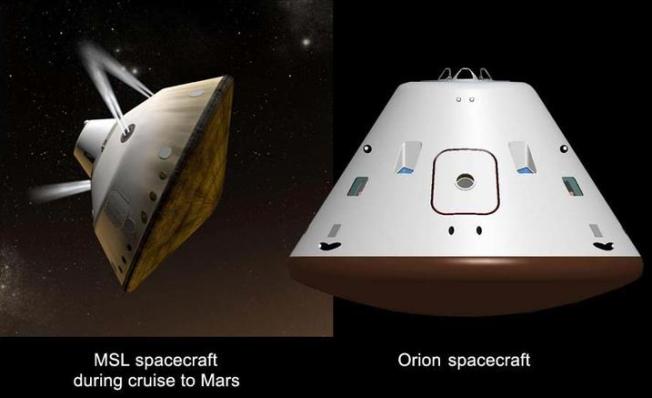
The result does not inspire - the equivalent dose of absorbed radiation is 2 times higher than the dose of the ISS. And in four - the one that is considered the maximum allowable for nuclear power plants.

That is, a six-month flight to Mars is roughly equivalent to 1 year spent in earth orbit or two in a nuclear power plant. Given that the total duration of the expedition should be about 500 days, the prospect does not open optimistic.
For a person, the accumulated radiation in 1 Sievert increases the risk of cancer by 5%. NASA allows its astronauts in their careers to recruit no more than 3% risk, or 0.6 sievert. Taking into account the fact that on the ISS the daily dose is up to 1 mSv, then the limiting period for astronauts in orbit is limited to about 600 days in an entire career.
On Mars itself, the radiation should be about two times lower than in space, due to the atmosphere and dust suspension in it, i.e. correspond to the level of the ISS, but accurate indicators have not yet been published. Interesting will be the performance of RAD in the days of dust storms - find out how the Martian dust is a good radiation screen.
')
Now the record of being in Earth orbit belongs to 55-year-old Sergey Krikalev - he has 803 days to his credit. But he scored them intermittently - in total, he made 6 flights from 1988 to 2005.
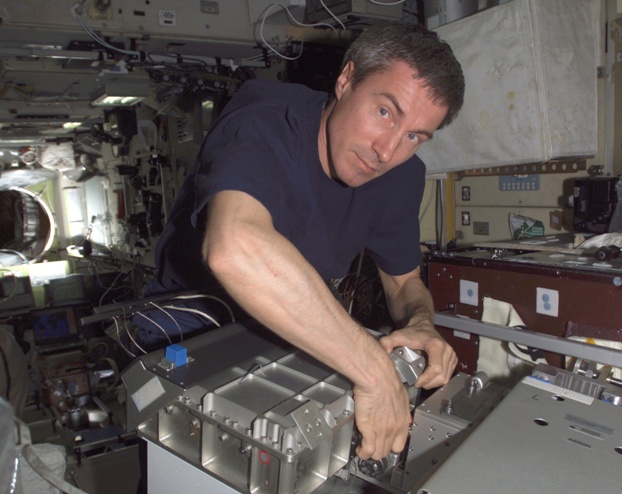
The RAD instrument consists of three silicon solid-state plates acting as a detector. Additionally, it has a crystal of cesium iodide, which is used as a scintillator . RAD is set so that during the landing you look at the zenith and capture the field at 65 degrees.
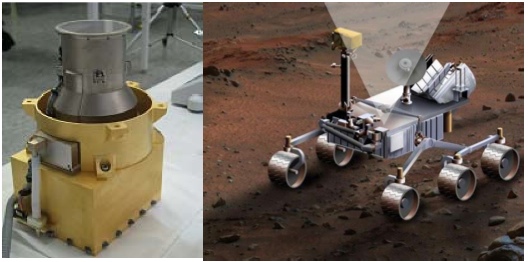
In fact, it is a radiation telescope that captures ionizing radiation and charged particles in a wide range.

Radiation in space arises mainly from two sources: from the Sun — during flares and coronary ejections, and from cosmic rays that arise during supernova explosions or other high-energy events in our and other galaxies.
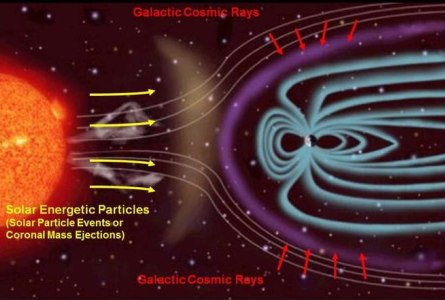
In the illustration: the interaction of the solar "wind" and the Earth's magnetosphere.
Cosmic rays make up the bulk of radiation in interplanetary travel. They account for the share of radiation at 1.8 mSv per day. Only three percent of the exposure accumulated Curiosity from the Sun. This is also due to the fact that the flight took place in a relatively quiet time. The outbreaks increase the total dose, and it approaches 2 mSv per day.

Peaks occur in solar flares.
Current technical means are more effective against solar radiation, which has low energy. For example, you can equip a protective capsule where astronauts can hide during solar flares. However, even 30 cm aluminum walls will not protect against interstellar cosmic rays. Lead probably would have helped better, but this will significantly increase the weight of the ship, which means the cost of its removal and acceleration.
The most effective means of minimizing exposure should be new types of engines, which significantly reduce the time of flight to Mars and back. NASA is currently working on a solar electro-jet engine and nuclear heat. The first can, in theory, accelerate up to 20 times faster than modern chemical engines, but acceleration will be very long due to low thrust. The device with such an engine is supposed to be sent to tow an asteroid that NASA wants to capture and transfer to lunar orbit for a subsequent visit by astronauts.
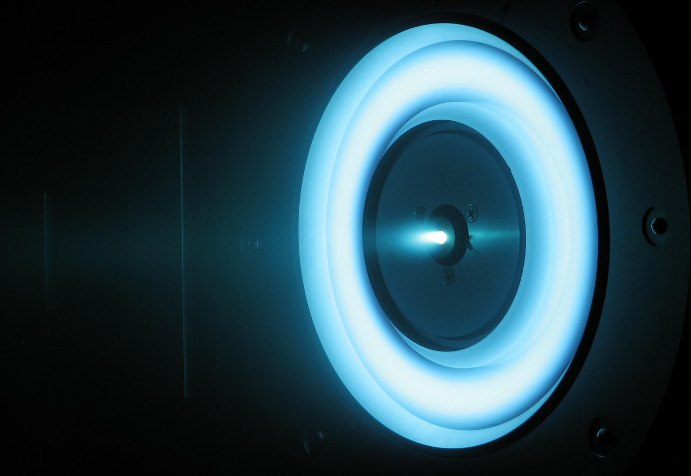
The most promising and promising developments on electric propulsion engines are being carried out according to the VASIMR project. But to travel to Mars, solar panels will not be enough - you will need a reactor.
The nuclear heat engine develops a specific impulse about three times higher than modern types of missiles. Its essence is simple: the reactor heats the working gas (hydrogen is assumed) to high temperatures without using an oxidizing agent, which is required by chemical rockets. The limit of the heating temperature is determined only by the material from which the engine itself is made.

But such simplicity also causes difficulties - it is very difficult to control the load. NASA is trying to solve this problem, but does not consider the development of NRE as a priority work.
The use of a nuclear reactor is still promising in that a part of the energy could be used to generate an electromagnetic field, which would additionally protect pilots both from cosmic radiation and from the radiation of its own reactor. The same technology would make the extraction of water on the Moon or asteroids profitable, that is, additionally stimulated the commercial use of space.
Although now this is nothing more than theoretical reasoning, it is possible that such a scheme will be the key to a new level of development of the Solar System.


The result does not inspire - the equivalent dose of absorbed radiation is 2 times higher than the dose of the ISS. And in four - the one that is considered the maximum allowable for nuclear power plants.

That is, a six-month flight to Mars is roughly equivalent to 1 year spent in earth orbit or two in a nuclear power plant. Given that the total duration of the expedition should be about 500 days, the prospect does not open optimistic.
For a person, the accumulated radiation in 1 Sievert increases the risk of cancer by 5%. NASA allows its astronauts in their careers to recruit no more than 3% risk, or 0.6 sievert. Taking into account the fact that on the ISS the daily dose is up to 1 mSv, then the limiting period for astronauts in orbit is limited to about 600 days in an entire career.
On Mars itself, the radiation should be about two times lower than in space, due to the atmosphere and dust suspension in it, i.e. correspond to the level of the ISS, but accurate indicators have not yet been published. Interesting will be the performance of RAD in the days of dust storms - find out how the Martian dust is a good radiation screen.
')
Now the record of being in Earth orbit belongs to 55-year-old Sergey Krikalev - he has 803 days to his credit. But he scored them intermittently - in total, he made 6 flights from 1988 to 2005.

The RAD instrument consists of three silicon solid-state plates acting as a detector. Additionally, it has a crystal of cesium iodide, which is used as a scintillator . RAD is set so that during the landing you look at the zenith and capture the field at 65 degrees.

In fact, it is a radiation telescope that captures ionizing radiation and charged particles in a wide range.

Radiation in space arises mainly from two sources: from the Sun — during flares and coronary ejections, and from cosmic rays that arise during supernova explosions or other high-energy events in our and other galaxies.

In the illustration: the interaction of the solar "wind" and the Earth's magnetosphere.
Cosmic rays make up the bulk of radiation in interplanetary travel. They account for the share of radiation at 1.8 mSv per day. Only three percent of the exposure accumulated Curiosity from the Sun. This is also due to the fact that the flight took place in a relatively quiet time. The outbreaks increase the total dose, and it approaches 2 mSv per day.

Peaks occur in solar flares.
Current technical means are more effective against solar radiation, which has low energy. For example, you can equip a protective capsule where astronauts can hide during solar flares. However, even 30 cm aluminum walls will not protect against interstellar cosmic rays. Lead probably would have helped better, but this will significantly increase the weight of the ship, which means the cost of its removal and acceleration.
The most effective means of minimizing exposure should be new types of engines, which significantly reduce the time of flight to Mars and back. NASA is currently working on a solar electro-jet engine and nuclear heat. The first can, in theory, accelerate up to 20 times faster than modern chemical engines, but acceleration will be very long due to low thrust. The device with such an engine is supposed to be sent to tow an asteroid that NASA wants to capture and transfer to lunar orbit for a subsequent visit by astronauts.

The most promising and promising developments on electric propulsion engines are being carried out according to the VASIMR project. But to travel to Mars, solar panels will not be enough - you will need a reactor.
The nuclear heat engine develops a specific impulse about three times higher than modern types of missiles. Its essence is simple: the reactor heats the working gas (hydrogen is assumed) to high temperatures without using an oxidizing agent, which is required by chemical rockets. The limit of the heating temperature is determined only by the material from which the engine itself is made.

But such simplicity also causes difficulties - it is very difficult to control the load. NASA is trying to solve this problem, but does not consider the development of NRE as a priority work.
The use of a nuclear reactor is still promising in that a part of the energy could be used to generate an electromagnetic field, which would additionally protect pilots both from cosmic radiation and from the radiation of its own reactor. The same technology would make the extraction of water on the Moon or asteroids profitable, that is, additionally stimulated the commercial use of space.
Although now this is nothing more than theoretical reasoning, it is possible that such a scheme will be the key to a new level of development of the Solar System.

Source: https://habr.com/ru/post/181608/
All Articles